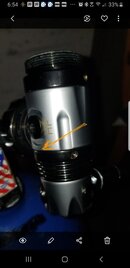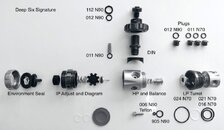Hey guys. I have taken a regulator rebuild class so I have a very limited understanding of how to take them apart and put them back together. I think I'm probably just dangerous at this point as I think I know something (that's false, I don't know anything ).
).
I've rebuilt a few and all has been great. I knew there would come a point that I would need to troubleshoot and that day is here. The regulator I've attached in the pictures and the video links leaks when I turn the tank on. It's a brand new regulator, and has done this since coming out of the box so I'm not sure there's anything I can do. I've taken it apart and swapped over parts either from a known working regulator or from the rebuild kit. The issue remains with this regulator.
It leaks indefinitely when I turn the tank on slightly / slowly, if I turn the tank on more there's an audible "pop" and she seals up. Any suggestions or pointers? The manufacturer agreed (which is awesome because I bought this regulator last year and it's been unused for 6 months) to pay for shipping both ways to find out what the issue is, but I like to tinker. It might go back at some point, but I'd like to try at least.
The 1st thing I did was test ip and it's rock solid. I set mine around 125-130 and it holds that just fine.
Videos; Dropbox - 21-07-01 - Simplify your life
Thoughts? I've also attached a picture breakdown of the regulator parts.
I've rebuilt a few and all has been great. I knew there would come a point that I would need to troubleshoot and that day is here. The regulator I've attached in the pictures and the video links leaks when I turn the tank on. It's a brand new regulator, and has done this since coming out of the box so I'm not sure there's anything I can do. I've taken it apart and swapped over parts either from a known working regulator or from the rebuild kit. The issue remains with this regulator.
It leaks indefinitely when I turn the tank on slightly / slowly, if I turn the tank on more there's an audible "pop" and she seals up. Any suggestions or pointers? The manufacturer agreed (which is awesome because I bought this regulator last year and it's been unused for 6 months) to pay for shipping both ways to find out what the issue is, but I like to tinker. It might go back at some point, but I'd like to try at least.
The 1st thing I did was test ip and it's rock solid. I set mine around 125-130 and it holds that just fine.
Videos; Dropbox - 21-07-01 - Simplify your life
Thoughts? I've also attached a picture breakdown of the regulator parts.






